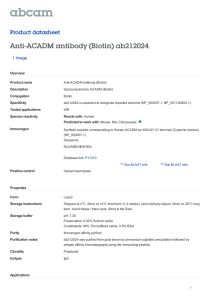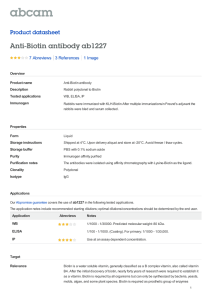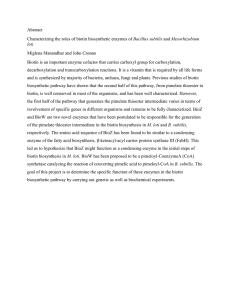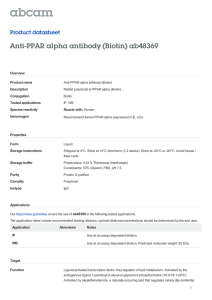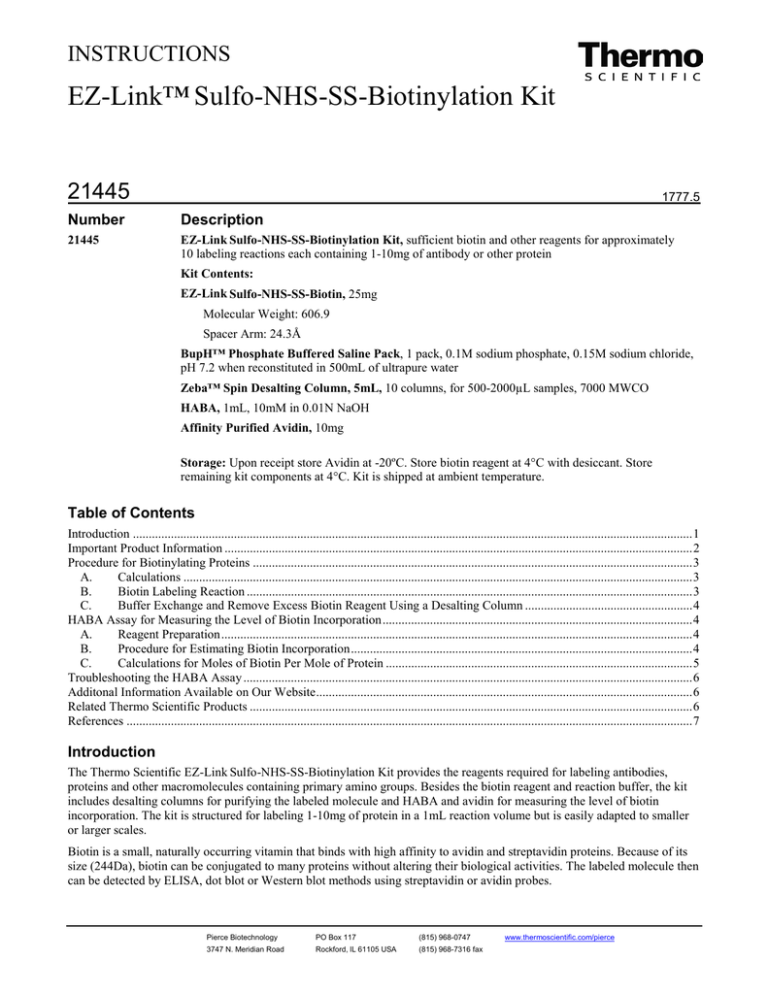
INSTRUCTIONS
EZ-Link™ Sulfo-NHS-SS-Biotinylation Kit
21445
1777.5
Number
Description
21445
EZ-Link Sulfo-NHS-SS-Biotinylation Kit, sufficient biotin and other reagents for approximately
10 labeling reactions each containing 1-10mg of antibody or other protein
Kit Contents:
EZ-Link Sulfo-NHS-SS-Biotin, 25mg
Molecular Weight: 606.9
Spacer Arm: 24.3Å
BupH™ Phosphate Buffered Saline Pack, 1 pack, 0.1M sodium phosphate, 0.15M sodium chloride,
pH 7.2 when reconstituted in 500mL of ultrapure water
Zeba™ Spin Desalting Column, 5mL, 10 columns, for 500-2000µL samples, 7000 MWCO
HABA, 1mL, 10mM in 0.01N NaOH
Affinity Purified Avidin, 10mg
Storage: Upon receipt store Avidin at -20ºC. Store biotin reagent at 4°C with desiccant. Store
remaining kit components at 4°C. Kit is shipped at ambient temperature.
Table of Contents
Introduction ................................................................................................................................................................................. 1
Important Product Information .................................................................................................................................................... 2
Procedure for Biotinylating Proteins ........................................................................................................................................... 3
A.
Calculations ................................................................................................................................................................. 3
B.
Biotin Labeling Reaction ............................................................................................................................................. 3
C.
Buffer Exchange and Remove Excess Biotin Reagent Using a Desalting Column ..................................................... 4
HABA Assay for Measuring the Level of Biotin Incorporation .................................................................................................. 4
A.
Reagent Preparation ..................................................................................................................................................... 4
B.
Procedure for Estimating Biotin Incorporation ............................................................................................................ 4
C.
Calculations for Moles of Biotin Per Mole of Protein ................................................................................................. 5
Troubleshooting the HABA Assay .............................................................................................................................................. 6
Additonal Information Available on Our Website ....................................................................................................................... 6
Related Thermo Scientific Products ............................................................................................................................................ 6
References ................................................................................................................................................................................... 7
Introduction
The Thermo Scientific EZ-Link Sulfo-NHS-SS-Biotinylation Kit provides the reagents required for labeling antibodies,
proteins and other macromolecules containing primary amino groups. Besides the biotin reagent and reaction buffer, the kit
includes desalting columns for purifying the labeled molecule and HABA and avidin for measuring the level of biotin
incorporation. The kit is structured for labeling 1-10mg of protein in a 1mL reaction volume but is easily adapted to smaller
or larger scales.
Biotin is a small, naturally occurring vitamin that binds with high affinity to avidin and streptavidin proteins. Because of its
size (244Da), biotin can be conjugated to many proteins without altering their biological activities. The labeled molecule then
can be detected by ELISA, dot blot or Western blot methods using streptavidin or avidin probes.
Pierce Biotechnology
PO Box 117
(815) 968-0747
3747 N. Meridian Road
Rockford, lL 61105 USA
(815) 968-7316 fax
www.thermoscientific.com/pierce
N-Hydroxysuccinimide (NHS) ester-activated biotins are the most popular type of biotinylation reagent. NHS esters react
efficiently with primary amino groups (-NH2) in pH 7-9 buffers to form stable amide bonds (Figure 1). Because antibodies
and other proteins generally contain multiple lysine (K) residues in addition to the N-terminus of each polypeptide, they have
multiple primary amines available as targets for labeling with NHS-activated biotin reagents. The sulfo-NHS ester reagent in
this kit is water-soluble, enabling reactions to be performed in the absence of organic solvents such as DMSO or DMF.
Unlike other biotin-labeling reagents, EZ-Link Sulfo-NHS-SS-Biotin contains a disulfide bond in its spacer arm, enabling
labeled proteins to be cleaved from the biotin group by treatment with dithiothreitol (DTT) or other reducing agents. This
feature is especially useful in affinity purification experiments where it is necessary to elute the biotinylated protein from its
bound state to avidin or streptavidin.
The EZ-Link Sulfo-NHS-SS-Biotinylation Kit combines the basic reagents, tools and easy-to-follow instructions for biotinlabeling amine-containing macromolecules. With this kit, even researchers who have never before labeled antibodies or other
proteins can expect to obtain results comparable to those obtained in commercial laboratories.
O
Na
O
O
S
O
O
N
O
O
O
S
S
HN
O
NH
N
H
S
Sulfo-NHS-SS-Biotin
O
O
Protein
Protein
N
H
NH2
Molecule with
Primary Amines
Na
S
S
N
H
O
O
O S
O
HN
O
NH
S
Biotinylated Molecule
N
OH
O
Sulfo-NHS Leaving Group
(later removed by gel filtration)
Figure 1. Reaction of Sulfo-NHS-SS-Biotin with primary amine. If drawn to scale, the oval representing the protein would
be many times larger than the reagent structures and would likely contain several amino groups. Note that Sulfo-NHS is a
leaving group (byproduct) in the reaction. The leaving group and any non-reacted biotin reagent are removed during the
desalting step.
Important Product Information
•
Sulfo-NHS-SS-Biotin is moisture-sensitive. Store the vial of biotin reagent at 4°C with desiccant. To avoid moisture
condensation onto the product, equilibrate vial to room temperature before opening.
•
As directed in the procedure, dissolve the biotin reagent immediately before use. The NHS-ester moiety readily
hydrolyzes and becomes non-reactive; therefore, weigh and dissolve only a small amount of the reagent at a time, and do
not prepare stock solutions for storage. Discard any unused reconstituted reagent.
•
Avoid buffers containing primary amines (e.g., Tris or glycine) as these compete with the intended reaction (see Figure
1). If necessary, dialyze or otherwise desalt to exchange the protein sample into an amine-free buffer such as phosphatebuffered saline (one packet is included in this kit).
•
Avoid buffers containing reducing agents during the labeling reaction to prevent cleavage of the reagent disulfide bond.
The desalting columns provided in this kit are best suited for processing reactions involving 1-10mg of protein in
approximately 0.5-2mL. For smaller amounts of protein or smaller reaction volumes, perform both the biotinylation
reaction and buffer exchanges in a single Thermo Scientific Slide-A-Lyzer MINI Dialysis Unit (See Additional
Information and Related Thermo Scientific Products). For reaction volumes that are larger than can be processed with a
desalting column, split the sample between two columns or use an appropriate Slide-A-Lyzer™ Dialysis Cassette for
buffer exchanges. For processing small volumes (i.e. 10-150µL) of peptides and other low molecular weight molecules,
Thermo Scientific Pierce C18 Spin Columns (Product No. 89870 or 89873) may be used.
Pierce Biotechnology
PO Box 117
(815) 968-0747
3747 N. Meridian Road
Rockford, lL 61105 USA
(815) 968-7316 fax
2
www.thermoscientific.com/pierce
Procedure for Biotinylating Proteins
A. Calculations
The extent of biotin labeling depends on the size and distribution of amino groups on the protein and the amount of reagent
used. Compared to reactions involving concentrated protein solutions, labeling reactions with dilute protein solutions require
a greater fold molar excess of biotin reagent to achieve the same incorporation level. Experiments that used a 20-fold molar
excess of biotin reagent to label 1-10mg/mL antibody (IgG) resulted in 4-6 biotin groups per antibody molecule. Adjust the
molar ratio of Sulfo-NHS-SS-Biotin to protein to obtain the desired level of incorporation.
1.
Calculate millimoles of Sulfo-NHS-SS-Biotin to add to the reaction for a 20-fold molar excess:
mL protein ×
mg protein
mL protein
•
2.
×
mmol protein
mg protein
×
20 mmol Biotin
= mmol Biotin
mmol protein
20 = Recommended molar fold excess of biotin reagent per protein sample
Calculate microliters of 10mM Sulfo-NHS-SS-Biotin (prepared in Step B.3) to add to the reaction:
607 mg
mmol Biotin ×
×
mmol Biotin
360 μL
2.2 mg
= μL Biotin Solution
•
607 = Molecular weight of Sulfo-NHS-SS-Biotin
•
360 = Microliters of water in which 2.2mg of Sulfo-NHS-SS-Biotin is dissolved to make a 10mM solution
Example: For 1mL of a 2mg/mL IgG (150,000 MW) solution, ~27µL of 10mM Sulfo-NHS-SS-Biotin will be added.
1 mL IgG ×
2 mg IgG
1 mL IgG
×
1 mmol IgG
×
20 mmol Biotin
150,000 mg IgG
0.000266 mmol Biotin ×
= 0.000266 mmol Biotin
1 mmol IgG
607 mg
×
mmol Biotin
360 μL
2.2 mg
= 26.4 μL Biotin Solution
B. Biotin Labeling Reaction
1.
Remove the vial of Sulfo-NHS-SS-Biotin from freezer and equilibrate it to room temperature before opening in Step 3.
2.
Dissolve 1-10mg protein in 0.5-2mL of phosphate buffered saline (PBS) according to the calculation made in Section A.
Prepare the Thermo Scientific BupH PBS as directed on the package label.
Note: Protein already dissolved in amine-free buffer at pH 7.2-8.0 may be used without buffer exchange. Proteins in Tris
or other amine-containing buffers must be exchanged into PBS. Perform buffer exchange of 0.5-2.0mL samples by
dialysis or using one of the desalting columns included in this kit, as described in Section C. Be aware that this kit
contains only 10 single-use desalting columns, sufficient for 10 biotinylation procedures when used only for Section C.
3.
Immediately before use, prepare 10mM of Sulfo-NHS-SS-Biotin by dissolving 2.2mg in 360µL ultrapure water.
4.
Add the appropriate volume of Sulfo-NHS-SS-Biotin solution (see calculations in Section A) to the protein solution.
Pierce Biotechnology
PO Box 117
(815) 968-0747
3747 N. Meridian Road
Rockford, lL 61105 USA
(815) 968-7316 fax
3
www.thermoscientific.com/pierce
5.
Incubate reaction on ice for two hours or at room temperature for 30-60 minutes.
Note: There is no harm in reacting longer than the specified time other than the possibility of ordinary protein
degradation or microbial growth.
Note: Although excess non-reacted and hydrolyzed biotin reagent remains in the solution, it is often possible to perform
preliminary tests of the labeled protein by ELISA or Western blot. Once function has been confirmed, buffer exchange
the labeled protein for optimal performance and stability using the procedure in Section C: Buffer Exchange using a
Desalting Column. If the HABA Assay will be performed to determine biotin incorporation, the protein must be purified
by buffer exchange first.
C. Buffer Exchange and Remove Excess Biotin Reagent Using a Desalting Column
1.
Prepare a Thermo Scientific Zeba Spin Desalting Column by breaking off the bottom plug and placing the column into a
15mL collection tube. Centrifuge the column at 1000 × g for 2 minutes, discard the storage buffer, and return column to
the same collection tube. Place a mark on the side of the column where the compacted resin is slanted upward. Place
column in centrifuge with the mark facing outward in all subsequent centrifugation steps.
2.
Equilibrate the column by adding 2.5mL of PBS to the top of the resin bed and centrifuging at 1000 × g for 2 minutes.
Discard the flow-through and repeat this step a total of 2-3 times.
3.
Place column into a new 15mL collection tube and apply protein sample directly onto the center of the resin bed. Allow
sample to absorb into the resin.
4.
Note: For samples < 1000µL, add 100µL ultrapure water on top of the absorbed sample to increase protein recovery.
5.
Centrifuge the column at 1000 × g for 2 minutes. The collected flow-through solution is the purified protein sample.
Store the protein solution in appropriate conditions.
HABA Assay for Measuring the Level of Biotin Incorporation
To estimate biotin incorporation, a solution containing the biotinylated protein is added to a mixture of HABA and avidin.
Because of its higher affinity for avidin, biotin displaces the HABA from its interaction with avidin and the absorbance at
500nm decreases proportionately. An unknown amount of biotin present in a solution is estimated in a single cuvette by
measuring the absorbance of the HABA-avidin solution before and after addition of the biotin-containing sample. The change
in absorbance relates to the amount of biotin in the sample.
Note: The biotin-labeled protein sample must be desalted or dialyzed to remove all traces of non-reacted and hydrolyzed
biotinylation reagent before the HABA assay is performed.
A. Reagent Preparation
Phosphate-buffered Saline
(PBS)
100mM sodium phosphate, 150mM NaCl; pH 7.2; Product No. 28372
HABA/Avidin Solution
Add 10mg of avidin and 600µL of 10mM HABA to 19.4mL of PBS. If prepared correctly, the
A500 of this solution will be 0.9-1.3 in a 1cm cuvette. The solution is stable for two weeks at
4°C. If a precipitate forms in the HABA solution, it can be filtered and then used.
Note: Avoid buffers containing potassium (e.g., Modified Dulbecco’s PBS), which will cause
precipitation in the assay. Empirically determine if other buffers are compatible by comparing
to results obtained using TBS or PBS.
B. Procedure for Estimating Biotin Incorporation
•
Procedure Option 1 – Cuvette Format
1.
Pipette 900µL of HABA/Avidin Solution into a 1mL cuvette.
2.
Measure the absorbance of the solution in the cuvette at 500nm and record the value as A500 HABA/Avidin.
3.
Add 100µL of biotinylated protein sample to the cuvette containing HABA/Avidin and mix well.
4.
Measure the absorbance of the solution in the cuvette at 500nm. Once the value remains fairly constant for at least
15 seconds, record the value as A500 HABA/Avidin/Biotin Sample. If the A500 HABA/Avidin/Biotin is < 0.3, dilute the
biotinylated protein sample and repeat the assay, but remember to account for the dilution in subsequent calculations.
5.
Proceed to Section C: Calculation of Moles of Biotin per Mole of Protein.
Pierce Biotechnology
PO Box 117
(815) 968-0747
3747 N. Meridian Road
Rockford, lL 61105 USA
(815) 968-7316 fax
4
www.thermoscientific.com/pierce
•
Procedure Option 2 – Microplate Format
1.
Pipette 180µL of HABA/Avidin Solution into a microplate well.
2.
Measure the absorbance at 500nm of the solution in the well and record the value as A500 HABA/Avidin.
3.
Add 20µL of biotinylated sample to the well containing the HABA/Avidin Solution. Mix the plate using an orbital
shaker or plate mixer.
4.
Measure the absorbance at 500nm of the solution in the well. Once the value remains fairly constant for at least 15
seconds, record the value as A500 HABA/Avidin/Biotin Sample.
5.
Proceed to Section C: Calculation of Moles of Biotin Per Mole of Protein.
C. Calculations for Moles of Biotin per Mole of Protein
Note: An automatic HABA Calculator is available at the website for performing these calculations.
These calculations are based on the Beer Lambert Law (Beer’s Law): Aλ = ελ bC
Where:
A is the absorbance of the sample at a particular wavelength (λ). The wavelength for the HABA assay is 500nm.
There are no units for absorbance.
ε is the absorptivity or extinction coefficient at the wavelength (λ). For HABA/avidin samples at 500nm, pH 7.0
extinction coefficient is equal to 34,000M-1cm-1.
b is the cell path length expressed in centimeters (cm). A 10mm square cuvette has a path length of 1.0cm. Using the
recommended microplate format volumes, the path length is typically 0.5cm.
C is the concentration of the sample expressed in molarity (= mol/L = mmol/mL).
The values needed for calculating the number of moles of biotin per mole of protein or sample are as follows:
•
•
•
•
•
1.
Concentration of the protein or sample used, expressed as mg/mL
Molecular weight (MW) of the protein, expressed as grams per mole (e.g., HRP = 40,000; IgG =150,000)
Absorbance at 500nm for HABA/Avidin Solution (A500 H\A)
Absorbance at 500nm for HABA/Avidin/Biotin reaction mixture (A500 H\A\B)
Dilution factor, if the sample is diluted before adding it to the HABA/Avidin Solution
Calculation #1 is for the concentration of biotinylated protein in mmol/mL (before any dilution for the assay procedure):
mmol protein per mL =
protein concentration (mg/mL)
= Calc #1
MW of protein (mg/mmol)
2.
Calculation #2 is for the change in absorbance at 500nm:
• Cuvette:
Note: The cuvette format requires the 0.9 correction
factor to adjust for dilution of the H\A Solution by the
biotinylated protein sample. The microplate format
does not require this correction factor because the
dilution effect is exactly offset by the increased height
and light path length of solution in the well.
∆A500 = (0.9 × A500 H\A) – (A500 H\A\B) = Calc#2
• Microplate:
∆A500 = (A500 H\A) – (A500 H\A\B) = Calc#2
3.
Calculation #3 is for the concentration of biotin in mmol per mL of reaction mixture:
mmol biotin
mL reaction mixture
=
ΔA500
(34,000 × b )
=
Calc # 2
(34,000 × b)
= Calc #3
Note: b is the light path length (cm) of the sample.
Use b = 1 with the cuvette format. Use b = 0.5 with
the microplate format when using a standard 96-well
plate and the volumes specified in the procedure. The
exact path length is the height of the solution through
which the plate reader measures the absorbance.
Pierce Biotechnology
PO Box 117
(815) 968-0747
3747 N. Meridian Road
Rockford, lL 61105 USA
(815) 968-7316 fax
5
www.thermoscientific.com/pierce
4.
Calculation #4 is for the mmol of biotin per mmol of protein:
=
mmol biotin in original sample
mmol protein in original sample
=
(mmol per mL biotin in reaction mixture)(10)(dilution factor)
Note: The original biotinylated protein sample was
diluted 10-fold in the reaction mixture. Therefore, a
multiplier of 10 is used in this step to convert the
biotin concentration in the reaction mixture to the
biotin concentration in the original sample. If the
original sample was diluted before performing the
assay, then the dilution factor must be used as well.
Calculation #4 yields the biotin:protein molar ratio
(average # of biotin molecules per protein molecule).
mmol per mL protein in original sample
=
(Calc #3) × 10 × dilution factor
Calc#1
Example HABA Assay calculation: In this example, the labeled protein is IgG (MW 150,000) at 0.69mg/mL. The
absorbance measurements were A500 H\A = 0.904 and A500 H\A\B =0.771.
1.
0.69 mg/mL
mmol biotinylated protein per mL =
= 4.6 × 10
−6
150,000 mg/mmol
2.
ΔA500 = (0.9 × 0.904) - 0.771 = 0.0426
mmol biotin
3.
=
mL reaction mixture
4.
0.0426
= 1.25 × 10
−6
34,000
mmol biotin
(1.25 × 10 −6 ) × 10 12.5 × 10 −6
=
=
= 2.72 biotin molecules per IgG molecule
mmol protein
4.6 × 10 −6
4.6 × 10 −6
Troubleshooting the HABA Assay
Problem
∆A500 in HABA
assay is ≤ 0
High levels of
biotinylation
Cause
Solution
The protein sample had no or a low level of
biotinylation because of limited accessible
functional groups on the protein
Incomplete mixing of reagent
Particulate in sample contributed to absorbance
Nonreacted biotin was not removed
Repeat biotinylation with alternative chemistry
(e.g., sulfhydryl reactive) or use a higher molar ratio
of biotinylation reagent
Completely solubilize and mix HABA/Avidin
before diluting
Filter protein sample to remove particulate
Dialyze or desalt sample before performing the
assay
Additonal Information Available on Our Website
•
HABA Calculator for computing the results associated with the HABA Assay measurements
•
Tech Tip #14: Perform labeling and other reactions in Slide-A-Lyzer Dialysis Cassettes
Related Thermo Scientific Products
21331
EZ-Link NHS-SS-Biotin, 100mg
69576
Slide-A-Lyzer MINI Dialysis Device Kit, 10K MWCO, 0.1mL
66382
Slide-A-Lyzer Dialysis Cassette Kit, 10K MWCO, 3mL
20347
Streptavidin Agarose Resin, 2mL
21126
Streptavidin, Horseradish Peroxidase Conjugated, 1mg
Pierce Biotechnology
PO Box 117
(815) 968-0747
3747 N. Meridian Road
Rockford, lL 61105 USA
(815) 968-7316 fax
6
www.thermoscientific.com/pierce
General References
Altin, J.G., et al. (1995). A one-step procedure for biotinylation and chemical crosslinking of lymphocyte surface and intracellular membraneassociated molecules. Anal Biochem 224:382-9.
Chaiet, I. and Wolf, F.J. (1964). The properties of streptavidin, a biotin-binding protein produced by streptomycetes. Arch Biochem Biophys 106:1-5.
Gitlin, G., et al. (1987). Studies of the biotin-binding site of avidin. Biochem J 242:923-6.
Gretch, D.R., et al. (1987). The use of biotinylated monoclonal antibody and streptavidin affinity chromatography to isolate herpes virus hydrophobic
proteins or glycoproteins. Anal Biochem 163:270-7.
Hnatowich, D.J., et al. (1987). Investigations of avidin and biotin for imaging applications. J Nucl Med 28:1294-302.
Shimkus, M., et al. (1985). A chemically cleavable biotinylated nucleotide: Usefulness in the recovery of protein-DNA complexes from avidin affinity
columns. Proc Natl Acad Sci 82:2593-7.
This product (“Product”) is warranted to operate or perform substantially in conformance with published Product specifications in effect at the time of sale,
as set forth in the Product documentation, specifications and/or accompanying package inserts (“Documentation”) and to be free from defects in material and
workmanship. Unless otherwise expressly authorized in writing, Products are supplied for research use only. No claim of suitability for use in applications
regulated by FDA is made. The warranty provided herein is valid only when used by properly trained individuals. Unless otherwise stated in the
Documentation, this warranty is limited to one year from date of shipment when the Product is subjected to normal, proper and intended usage. This
warranty does not extend to anyone other than the original purchaser of the Product (“Buyer”).
No other warranties, express or implied, are granted, including without limitation, implied warranties of merchantability, fitness for any particular
purpose, or non infringement. Buyer’s exclusive remedy for non-conforming Products during the warranty period is limited to replacement of or
refund for the non-conforming Product(s).
There is no obligation to replace Products as the result of (i) accident, disaster or event of force majeure, (ii) misuse, fault or negligence of or by Buyer, (iii)
use of the Products in a manner for which they were not designed, or (iv) improper storage and handling of the Products.
Current product instructions are available at www.thermoscientific.com/pierce. For a faxed copy, call 800-874-3723 or contact your local distributor.
© 2012 Thermo Fisher Scientific Inc. All rights reserved. Unless otherwise indicated, all trademarks are property of Thermo Fisher Scientific Inc. and its
subsidiaries. Printed in the USA.
Pierce Biotechnology
PO Box 117
(815) 968-0747
3747 N. Meridian Road
Rockford, lL 61105 USA
(815) 968-7316 fax
7
www.thermoscientific.com/pierce


